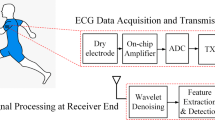Abstract
Intermittent disturbances are common in ECG signals recorded with smart clothing: this is mainly because of displacement of the electrodes over the skin. We evaluated a novel adaptive method for spatio-temporal filtering for heartbeat detection in noisy multi-channel ECGs including short signal interruptions in single channels. Using multi-channel database recordings (12-channel ECGs from 10 healthy subjects), the results showed that multi-channel spatio-temporal filtering outperformed regular independent component analysis. We also recorded seven channels of ECG using a T-shirt with textile electrodes. Ten healthy subjects performed different sequences during a 10-min recording: resting, standing, flexing breast muscles, walking and pushups. Using adaptive multi-channel filtering, the sensitivity and precision was above 97% in nine subjects. Adaptive multi-channel spatio-temporal filtering can be used to detect heartbeats in ECGs with high noise levels. One application is heartbeat detection in noisy ECG recordings obtained by integrated textile electrodes in smart clothing.





Similar content being viewed by others
References
Axisa F, Schmitt PM, Gehin C, Delhomme G, Mcadams E, Dittmar A (2005) Flexible technologies and smart clothing for citizen medicine, home healthcare, and disease prevention. IEEE Trans Inf Technol Biomed 9:325–336
Barros AK, Mansour A, Ohnishi N (1998) Removing artifacts from electrocardiographic signals using independent component analysis. Neurocomputing 22:173–186
Berglin L, Ekström M, Lindén M (2005) Monitoring health and activity by Smartwear. In: Thirteenth nordic baltic conference biomedical engineering and medical Physics, Umeå, Sweden, pp 251–252
Carpi F, De Rossi D (2005) Electroactive polymer-based devices for e-textiles in biomedicine. IEEE Trans Inf Technol Biomed 9:295–318
Castells F, Rieta JJ, Millet J, Zarzoso V, Associate (2005) Spatiotemporal blind source separation approach to atrial activity estimation in atrial tachyarrhythmias. IEEE Trans Biomed Eng 52:258–267
Friesen GM, Jannett TC, Jadallah MA, Yates SL, Quint SR, Nagle HT (1990) A comparison of the noise sensitivity of nine QRS detection algorithms. IEEE Trans Biomed Eng 37:85–98
Gritzali F (1988) Towards a generalized scheme for QRS detection in ECG waveforms. Signal processing 15:183–192
Hyvärinen A (1999) Fast and robust fixed-point algorithms for independent component analysis. IEEE Trans Neural Netw 10:626–634
Hyvärinen A, Karhunen J, Oja E (2001) Independent component analysis. Wiley, New York
Karlsson JS, Bäcklund T, Edström U (2003) A new wireless multi-channel data system for acquisition and analysis of physiological signals. In: Seventeenth international symposium on biotelemetry. Brisbane, Australia
Karlsson M, Ragnarsson F, Östlund N, Edström U, Bäcklund T, Karlsson JS, Wiklund U (2005) Wireless system for real-time recording of heart rate variability. In: Thirteenth nordic baltic conference biomedical engineering and medical physics, Umeå, Sweden, pp 168–169
Owis MI, Youssef AB, Kadah YM (2002) Characterisation of electrocardiogram signals based on blind source separation. Med Biol Eng Comput 40:557–564
Paradiso R, Loriga G, Taccini N (2005) A wearable health care system based on knitted integrated sensors. IEEE Trans Inf Technol Biomed 9:337–444
Portet F, Hernandez AI, Carrault G (2005) Evaluation of real-time QRS detection algorithms in variable contexts. Med Biol Eng Comput 43:379–385
Ragnarsson F (2005) Adaptive multichannel filter for ECG analysis. Masters thesis, Umeå University, Sweden
Ragnarsson F, Östlund N, Wiklund U (2005) Adaptive multichannel filter for heart beat detection. In Thirteenth nordic baltic conference biomedical engineering and medical physics, Umeå, Sweden, pp 299–300
Rieta JJ, Castells F, Sanchez C, Zarzoso V, Millet J (2004) Atrial activity extraction for atrial fibrillation analysis using blind source separation. IEEE Trans Biomed Eng 51:1176–1186
Stögbauer S, Kraskov A, Ashtakov SA, Grassberger P (2004) Least-dependent-component analysis based on mutual information. Phys Rew E 70:066123-1–0661231-7
Taccini N, Loriga G, Dittmar A, Paradiso R, Milior S (2004) Knitted bioclothes for health monitoring. In: Twenty-sixth annual international conference of the IEEE engineering in medicine and biology society. San Francisco, USA
Östlund N., Wiklund U, Yu J, Karlsson JS (2005) Adaptive spatio-temporal filtration of bioelectrical signals. In: Twenty-seventh annual international conference of the IEEE engineering in medicine and biology society. Shanghai, China
Östlund N, Yu J, Karlsson JS (2006) Adaptive spatio-temporal filtering of multichannel surface EMG signals. Med Biol Eng Comput 44:209–215
Zarzoso V, Nandi AK, Bacharakis E (1997) Maternal and foetal ECG separation using blind source separation methods. IMA J Math Appl Med Biol 14:207–225
Acknowledgments
The authors acknowledge the technical assistance by Tomas Bäcklund and Urban Edström. We are also grateful for the preliminary analyses performed by Fredrik Ragnarsson. The study was supported by grants from the National Institute for Working Life, Sweden, the Heart Foundation of Northern Sweden, and the Swedish Research Council (grant no. 2003-4833).
Author information
Authors and Affiliations
Corresponding author
Rights and permissions
About this article
Cite this article
Wiklund, U., Karlsson, M., Östlund, N. et al. Adaptive spatio-temporal filtering of disturbed ECGs: a multi-channel approach to heartbeat detection in smart clothing. Med Bio Eng Comput 45, 515–523 (2007). https://doi.org/10.1007/s11517-007-0183-0
Received:
Accepted:
Published:
Issue Date:
DOI: https://doi.org/10.1007/s11517-007-0183-0




